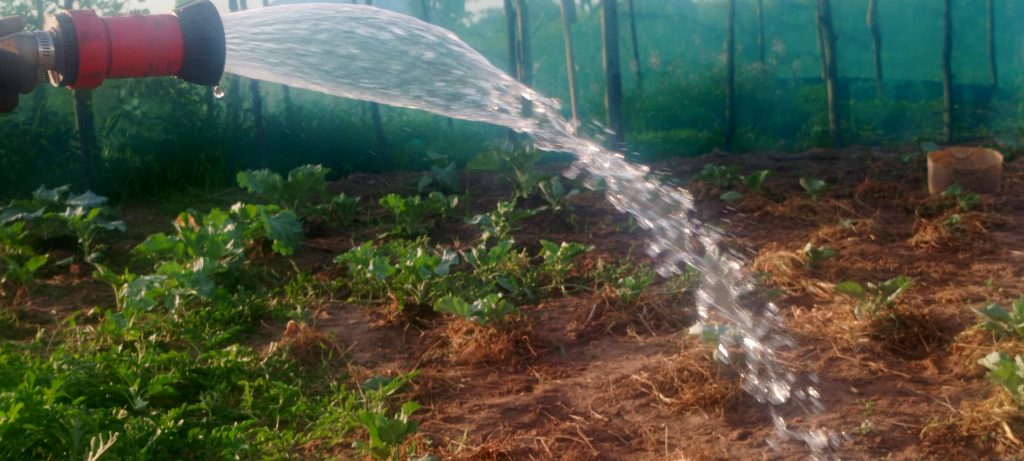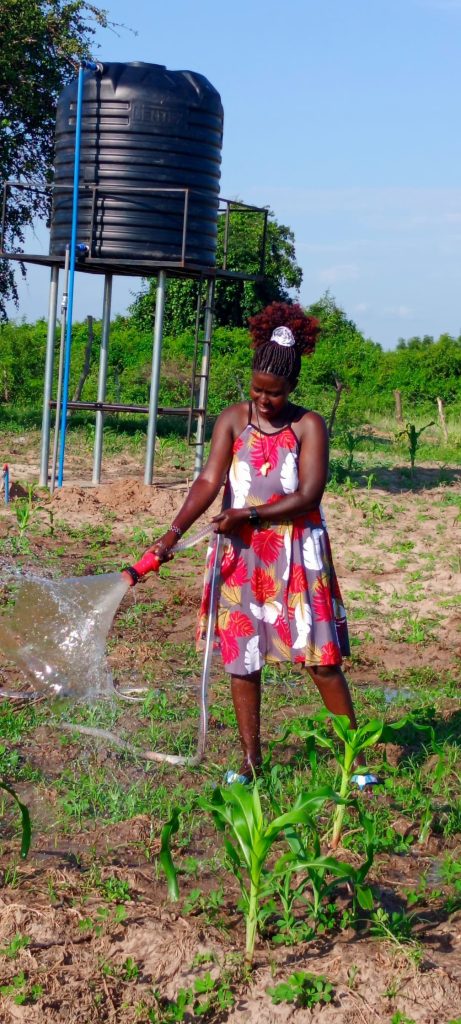
Harnessing Irrigation for Resilient Farming: AFRICE’s Work in Buliisa
For generations, farming in Buliisa District has depended almost entirely on the cycle of seasonal rains. When the rains came on time, crops flourished and families could count on a good harvest. But in recent years, the changing climate has disrupted this cycle. Rains are no longer reliable, dry spells stretch longer than expected, and crops that once thrived now shrink in the fields. For smallholder farmers who rely on their gardens for both food and income, this has created growing uncertainty, food shortages, and frustration. Many households have been forced to live with the fear that each planting season could end in disappointment.
It is against this background that the African Institute for Culture and Ecology (AFRICE), in partnership with Buliisa District Local Government and support from Biovision Foundation introduced an irrigation system at the Community Seed Learning Center (CSLC) in Kisyansya Village Buliisa district. Unlike individual farms where rain remains the only water source, the CSLC gardens are sustained by a reliable irrigation system that provides water even in the harshest dry seasons. This system not only keeps crops alive but also demonstrates to farmers that agriculture can thrive without depending solely on rainfall. Farmers from surrounding communities come to the Center to observe, participate and receive training on how irrigation works, how it can be managed, and how it can be combined with agroecological practices to restore both food security and environmental health.
The irrigation system at the CSLC waters bananas, vegetables, and a variety of crops that remain green and productive when the rest of the district struggles with dryness. For many farmers, this sight alone is a powerful evidence that change is possible. It challenges the old belief that farming must stop when the rains do, and it inspires conversations about resilience and adaptation. In fact, crops like bananas which most farmers in Buliisa once thought could not survive in their soils are now thriving under irrigation showing that new possibilities exist for diversifying food and income. One of the small holder farmer, Mrs. Violet Bitamale, Kisyansya village, shared,
Training sessions at the CSLC have become practical classrooms. Farmers are not just passive observers; they are involved in learning how to manage water flow, how to schedule irrigation, and how to integrate these practices with mulching, organic fertilizers, and intercropping. These lessons prepare them for the day when irrigation becomes more accessible to their own households. As Ms. Juliet Zalwango AFRICE’s agroecology trainer, explained, “This system is not only about watering crops. It is a tool for knowledge. Farmers who come here see what is possible and return home with new skills and ideas that can prepare them for the future.”

Irrigation at work giving life to the garden, ensuring healthy crops and food for tomorrow. Juliet Zalwango spraying water to the crops in the demonstration garden at CSLC
Even though the irrigation system remains physically at the CSLC, its impact extends far beyond its pipes and sprinklers. Each farmer who trains there carries new knowledge and confidence back to their homes. They share insights with neighbors, influence farming discussions in community groups, and spread awareness that farming does not have to be at the mercy of the climate. This wave effect is perhaps the greatest value of the project transforming the mindset of farmers who once believed that agriculture was only possible during rainy seasons.
However, for irrigation to spread widely across Buliisa, government support will be essential. No individual smallholder farmer can afford the costs of installing such a system on their own. There is an urgent need for the government to step in with subsidies that make irrigation affordable for rural households. Without such measures, many farmers who are eager to adopt irrigation will remain excluded simply because of the high costs involved.
Farmers across the district have already expressed great interest in irrigation, inspired by what they see at the CSLC. With Lake Albert and several rivers in Buliisa, the natural resources to support irrigation already exist. What is needed now is a deliberate government effort to design schemes that draw on these water bodies to serve wider farming communities. Harnessing these resources would turn irrigation from a demonstration into a district-wide solution that builds food security and resilience.
We thank the Buliisa District Local Government for the support it has already provided towards this initiative. Their partnership has been instrumental in making the irrigation demonstration a reality. Yet, much more is still needed. Scaling irrigation across the district requires sustained investment, clear policies, and stronger collaboration with development partners to ensure that the lessons of Kisyansya reach every village.
But the future of irrigation in Buliisa cannot rest on demonstrations alone. For the lessons of the CSLC to take root across communities, different stakeholders must act together. The Buliisa District Local Government has already shown leadership in supporting this work, and their continued engagement will be vital in scaling irrigation across the district. With Lake Albert and surrounding rivers as abundant waters sources, government can take a bold step by developing larger schemes and subsidizing irrigation costs so that even smallholder farmers can benefit. At present, no individual farmer can afford to establish such system alone, yet the demand among communities is growing rapidly.
Development partners like Biovision Foundation and other NGOs can also play a key role in expanding access by supporting affordable, small-scale systems while continuing to invest in farmer training. Communities themselves can form farmer groups to pool resources, share knowledge, and advocate for better access to technologies that strengthen resilience. Policymakers, on the other hand, can ensure that favorable subsidies and incentives are put in place to accelerate the spread of irrigation beyond demonstration sites.
As AFRICE’s Executive Director, Mr. Tabaro Dennis, reflected, “Our vision is to empower farmers with the skills they need today so that tomorrow, when irrigation becomes more accessible, they will already be prepared. What we are doing here is planting resilience.”
The irrigation system introduced and conducted by AFRICE, with support from Biovision Foundation and the Buliisa District Local Government, is therefore more than a piece of equipment. It is a living classroom, a source of inspiration, and a symbol of hope. It waters crops, but it also waters ideas of resilience, self-reliance, and the possibility of thriving in the face of climate change. While it currently serves only the demonstration gardens at the Center, its greatest impact lies in the knowledge and confidence it gives to farmers across Buliisa. With stronger partnerships, greater investment, and collective action, the lessons learned here can one day spread into every household garden ensuring that farmers are better prepared for the uncertainties of tomorrow and that communities remain nourished, resilient, and full of hope.